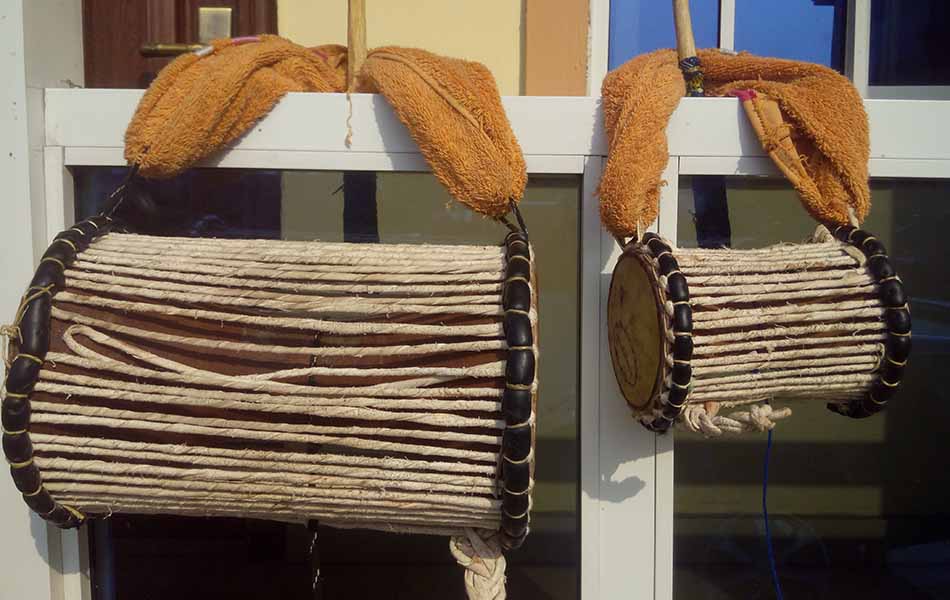Samuel Akinbo has his hands full when it comes to researching the talking drum.

The UBC Linguistics doctoral student and Language Sciences member found drummers are able to represent syllables, lexical tones and tonal processes of Yorùbá speech with the gángan, a talking drum used in Nigeria, in a paper published last June in Linguistique et Langues Africaines. And next year, Akinbo will present research at the Expression, Language, and Music conference which examines how Yorùbá speakers linguistically imitate and interpret musical patterns that are not themselves based on speech imitation.
But this work barely scratches the surface of the research questions around the instrument which imitates tonal language, says Akinbo's supervisor Linguistics professor and Language Sciences member Douglas Pulleyblank. "An issue that comes up in this kind of research is whether the musical form of language closely follows the surface acoustics of spoken language or whether the musical form represents a more abstract level of language. Akinbo’s research is fascinating because his results are different in this respect from some earlier work."
If you want to know your ancestors, the origin of where you came from, insult your drummer. Your drummer will tell you where your forefathers came from.
Samuel Akinbo
Talking drums are instruments made of thin goatskin and rope that can be manipulated by drummers to produce different tones, or pitch contrasts. In Yorùbá and other tonal languages, tones signal difference in the meaning of two or more words. For example, the difference between [rá] ‘disappear’, [ra] ‘massage’ and [rà] ‘buy’ in Yorùbá involves high, mid and low pitch contrasts respectively.
Akinbo's research looks at the most popular kind of talking drum in Nigeria, the gángan. Because they can produce tones, as well as how tones interact when played in sequence, the drums can be used to 'talk', or communicate in a tonal language, including over long distance. And their study begs many questions, Akinbo says, including how language acquisition occurs, and how drummers acquire drumming knowledge, including the physical nuances needed to articulate meaning.
In order to communicate via a talking drum, one must learn the spoken language connected with it, given drummers use not just tones, but tonal interaction, and context, to convey meaning, says Akinbo. Drummers will often use proverbs to convey meaning - and mockery - through the drum. If people don't know the proverb referenced, they might not understand they are being provoked, or mocked, says Akinbo. In addition, ambiguity is part of the language, when a tonal pattern can be the same for two different words.
The drum language is very important in the sense that it tells you the knowledge that people really have about their language, they're not only performers, they are linguists.
In this way, drummers are historians, says Akinbo, and will know the history of people in a community. "If you want to know your ancestors, the origin of where you came from, insult your drummer. Your drummer will tell you where your forefathers came from."
Akinbo's study investigated five drummers in Nigeria in 2019, and it is novel in its linguistic, rather than socioenvironmental, examination. It found that the number of syllables in a word directly corresponded to the number of strikes on the drum membrane, and that the drummers tightened and loosened the vibrating membrane to articulate the three tones in Yorùbá. As well, tonal processes, such as high-falling or low-rising pitch contours on the second note, were musically rendered.
His future research will look at what came first: the drum or the language, investigating whether listeners imitate the music of the drum when speaking Yorùbá, or whether the drum imitates the language.
Further work could help researchers answer questions about how humans imitate and interpret sounds in their environment, and about the best way to go about musical education, Akinbo says. "It's not like writing things on paper, it's writing stuff with sticks and the leather of an animal."
Click here for an example of the talking drum.
Image credit: Bamidele S. Ajayi, licensed under the Creative Commons Attribution-Share Alike 4.0 International license. This image has been resized and cropped.
